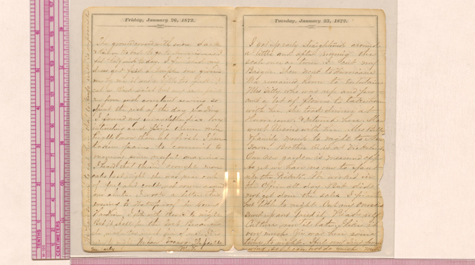Personal pages shine light on lives of Black women in late 1800s
The handwriting is neat but faded, and the pages have deteriorated over time.
Mary Virginia Montgomery’s written words may not be as legible as they were when she first wrote them in 1872, but they are giving William & Mary students insight into what her life was like in the days after her emancipation.
The students in Professor Jennifer Putzi’s 19th-century African American women’s diaries course, cross-listed in both English and gender, sexuality and women’s studies, are working together to transcribe the scanned pages of Montgomery’s diary that was obtained from the Library of Congress.
“She was 22 and had an active role in her family’s business. She was incredibly well-educated. She was a self-starter,” Putzi said. “She was an amazing young woman.”
Putzi estimates that there are fewer than 10 diaries in public record of Black women prior to 1900, and her students will study four of them this semester. In addition to the transcription project, the students will read from the diaries of Emilie Davis, Frances Rollin and Charlotte Forten Grimke.
Extant diaries by Black women in the mid- to late-19th century reveal a culture of life-writing, self-education and personal introspection, Putzi said. Her course discusses conventions of diary writing and histories of African American literacy and education.
Diary entry: Tuesday, April, 16, 1872
“After supper I took up Darwin on the Origin of the Species. It bids to be interesting & will entertain me many nights.” – Mary Virginia Montgomery
Montgomery’s family was enslaved by Joseph Davis, the older brother of Jefferson Davis, the president of the Confederacy. Her father, Benjamin Montgomery, eventually purchased Davis’ land, called Davis Bend, after the Civil War.
Mary Virginia was a bookkeeper at a store located at Davis Bend.
“She was always writing about what she was reading and learning,” Putzi said. “At the end of that year, she and her sister went to Oberlin College (in Ohio). I told my students that we need to get the number of how many Black women went to college in 1872 because I don’t think it was very high.”
Finding commonality with Montgomery’s studies has made the transcription process even more rewarding for the William & Mary students.
“I thought it just so cool that she was learning about Darwin for fun in her free time and seemed to enjoy it,” said Madeline Dort ’23, who said the course is “easily my favorite class.”
Diary entry: Monday, December 16, 1872
“Weather somewhat cloudy. Bob went up the street and purchased a few things for the Orphan’s box, on returning I fell down in the street. I was more ashamed than hurt.” – Montgomery
Nineteenth-century diaries recorded important moments, like weddings and births, but they also documented everyday life.
“When we are deciphering her text, we are all able to create a new understanding of her world as it really was – running errands, practicing and really mastering the piano, gardening, attending local functions, studying, etc.,” Dort said.
Dort says reading about Montgomery’s daily life has been “incredibly enlightening.”
“Whenever I’m teaching about diaries, I’m always a little bit worried that they’re not quite going to fulfill this sort of dream of what a diary looks like, but I think they’re actually way more interesting for that reason because we see their lives are both very like and unlike ours,” Putzi said.
While Montgomery’s diary chronicled her everyday life, it also included some mystery. Students discovered code on some of the pages. Dort and her classmates think it’s a form of shorthand, and they are working to decipher it.
Rewarding work
In the past, Putzi has conducted two freshman seminars on American women’s diaries. She got the idea for a full-scale course while working on her own transcription project during the pandemic.
She transcribed Rollin’s diary and found the work to be quite invigorating. It was a good way for her to keep her mind off all the pandemic news swirling around her. She is currently working on an edition of that diary.
“I found the work so interesting and so rewarding that I wanted to see if I could actually have a class on it,” Putzi said.
The course, which has 27 students, mixes traditional work with non-traditional assignments, like the transcription project. Moreover, the students will work in small groups with the Studio for Teaching & Learning Innovation to write, edit and produce a five-minute podcast focused on a story that appeals to them from one or more of the diaries they are studying.
Furthermore, the class made a visit to the Special Collections Research Center at Swem Library to see what diaries from this era commonly looked like.
At the beginning of the semester, Putzi assigned each student 12-13 pages of Montgomery’s diary to transcribe. When those transcriptions are complete, the students will exchange their work with another student for revisions before submitting them to Putzi for a final review.
When all the edits are complete, the course will use the transcribed diary as a class text later this semester.
“We’ll read the whole thing at the end of the semester and use all the tools that we gained over the course of the semester to analyze it,” Putzi said. “I’m hoping they feel kind of an ownership over the material because they put all of this original work into it.”
















